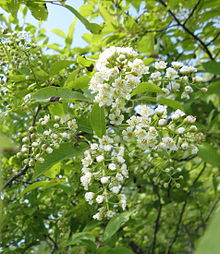- Prunus virginiana
-
Prunus virginiana 
Prunus virginiana var. virginiana (eastern chokecherry) in bloom Scientific classification Kingdom: Plantae (unranked): Angiosperms (unranked): Eudicots (unranked): Rosids Order: Rosales Family: Rosaceae Genus: Prunus Subgenus: Padus[1] Species: P. virginiana Binomial name Prunus virginiana
L.Prunus virginiana, commonly called chokecherry, bitter-berry, or Virginia bird cherry,[2] is a species of bird cherry (Prunus subgenus Padus) native to North America, where it is found almost throughout the continent except for the Deep South and the far north.
Contents
Growth
It is a suckering shrub or small tree growing to 5 m tall. The leaves are oval, 3–10 cm long, with a coarsely serrated margin. The flowers are produced in racemes of 15-30 in late spring (well after leaf emergence). The fruit are about 1 cm diameter, range in color from bright red to black, with a very astringent, sour taste. The very ripe berries are dark in color and less astringent than the red berries.
Etymology
The chokeberries, genus Aronia, are often mistakenly called chokecherries. This naming confusion is easy to understand considering there is a cultivar of the chokecherry Prunus virginiana 'Melanocarpa'[3][4] and a species of chokeberry named Aronia melanocarpa.[5] In fact, the two plants are not close relatives within their subfamily Spiraeoideae.
Characteristics
Chokecherries are very high in antioxidant pigment compounds, such as anthocyanins. They share this property with chokeberries, further contributing to confusion.
Varieties
Prunus virginiana is sometimes divided into two varieties, P. virginiana var. virginiana (the eastern chokecherry), and P. virginiana var. demissa (the western chokecherry).[6]
 Chokecherry - habit
Chokecherry - habit
The wild chokecherry is often considered a pest, as it is a host for the tent caterpillar, a threat to other fruit plants. However, there are more appreciated cultivars of the chokecherry, such as 'Goertz', which has a nonastringent, and therefore palatable, fruit. Research at the University of Saskatchewan seeks to find and create new cultivars to increase production and processing.[7]
The chokecherry is closely related to the black cherry (Prunus serotina) of eastern North America; it is most readily distinguished from that by its smaller size (black cherry trees can reach 30 m tall), smaller leaves, and sometimes red ripe fruit. The chokecherry leaf has a finely serrated margin and is dark green above with a paler underside, while the black cherry leaf has numerous blunt edges along its margin and is dark green and smooth.[8][9]
The name chokecherry has also been used (as Amur chokecherry) for the related Manchurian cherry or Amur cherry (Prunus maackii).
Consumption
For many Native American tribes of the Northern Rockies, Northern Plains, and boreal forest region of Canada and the United States, chokecherries were the most important fruit in their diets.[10] The bark of chokecherry root was once made into an asperous-textured concoction used to ward off or treat colds, fever and stomach maladies by native Americans[11] The inner bark of the chokecherry, as well as red osier dogwood, or alder, was also used by Native Americans in their smoking mixtures, known as kinnikinnick, to improve the taste of the bearberry leaf.[12] The chokecherry fruit can be used to make a tasty jam, jelly, or syrup, but the bitter nature of the fruit requires sugar to sweeten the preserves.
Chokecherry is toxic to horses, and moose, cattle, goats, deer, and other animals with segmented stomachs (rumens), especially after the leaves have wilted (such as after a frost or after branches have been broken) because wilting releases cyanide and makes the plant sweet. About 5–10 kg of foliage can be fatal. Symptoms of a horse that has been poisoned include heavy breathing, agitation, and weakness. The leaves of the chokecherry serve as food for caterpillars of various Lepidoptera. See List of Lepidoptera which feed on Prunus.
In 2007, Governor John Hoeven signed a bill naming the chokecherry the official fruit of the state of North Dakota, in part because its remains have been found at more archeological sites in the Dakotas than anywhere else.[13]
Chokecherry is also used to craft wine in the western United States mainly in the Dakotas and Utah as well as in Manitoba, Canada.[citation needed]
See also
References
- ^ Rehder, A. 1940, reprinted 1977. Manual of cultivated trees and shrubs hardy in North America exclusive of the subtropical and warmer temperate regions. Macmillan publishing Co., Inc, New York.
- ^ USDA GRIN
- ^ Prunus virginiana--Chokecherry, Michigan State University
- ^ http://www.laspilitas.com/plants/545.htm
- ^ http://www.msue.msu.edu/msue/imp/modzz/00000145.html
- ^ Farrar, J.L. 1995. Trees in Canada. Canadian Forest Service and Fitzhenry and Whiteside Limited, Markham.
- ^ http://www.agr.gov.sk.ca/afif/Projects/19960373.pdf
- ^ Edible Wild Plants A North American Field Guide, Thomas S. Elias, Peter A. Dykeman, Sterling Publishing Company Inc., New York, NY, 1990. isbn:0-8069-7488-5
- ^ http://www.cnr.vt.edu/dendro/dendrology/syllabus/factsheet.cfm?ID=238
- ^ http://www.wildfoods.info/wildfoods/chokecherry.html
- ^ pg. 81, Trees of Michigan and the Upper Great Lakes 6th edition, Norman F. Smith, Thunder Bay Press, 2002
- ^ Staff (2009) "Bearberry" Discovering Lewis and Clark The Lewis and Clark Fort Mandan Foundation
- ^ Kindscher, K. 1987. Edible Wild Plants of the Prairie: An Ethnobotanical Guide
Sources
External links
Categories:- Cherries
- Fruit
- Flora of the Eastern United States
- Flora of the Western United States
- Flora of Eastern Canada
- Flora of Western Canada
- Flora of Alaska
- Flora of Idaho
- Trees of Michigan
- Flora of Montana
- Trees of North Carolina
- Flora of California chaparral and woodlands
- Flora of the Rocky Mountains
- Flora of the Sierra Nevada region (U.S.)
- Traditional Native American medical plants
- Medicinal plants
- Edible nuts and seeds
- Garden plants of North America
- Trees of Ontario
Wikimedia Foundation. 2010.

